| dc.contributor.author | Tsenov, Rostyslav-Mykola | |
| dc.date.accessioned | 2021-04-30T17:53:36Z | |
| dc.date.available | 2021-04-30T17:53:36Z | |
| dc.date.issued | 2021-04-13 | |
| dc.identifier.citation | Tsenov, Rostyslav-Mykola. Improving LULC Map Production via Semantic Segmentation and Unsupervised Domain Adaptation; A Thesis submitted to the Faculty of Graduate Studies of The University of Winnipeg in partial fulfillment of the requirements of the degree of Master of Science, Department of Applied Computer Science, University of Winnipeg. Winnipeg, Manitoba, Canada: University of Winnipeg, 2021. DOI: 10.36939/ir.202104301247. | en_US |
| dc.identifier.uri | https://hdl.handle.net/10680/1935 | |
| dc.description.abstract | In recent years, a lot of remote sensing problems benefited from the improvements made in deep learning. In particular, deep learning semantic segmentation algorithms have provided improved frameworks for the automated production of land-use and land-cover (LULC) map generation. Automation of LULC map production can significantly increase its production frequency, which provides a great benefit to areas such as natural resource management, wildlife habitat protection, urban expansion, damage delineation, etc. In this thesis, many different convolutional neural networks (CNN) were examined in combination with various state-of-the-art semantic segmentation methods and extensions to improve the accuracy of predicted LULC maps. Most of the experiments were carried out using Landsat 5/7 and Landsat 8 satellite images. Additionally, unsupervised domain adaption (UDA) architectures were explored to transfer knowledge extracted from a labelled Landsat 8 dataset to unlabelled Sentinel-2 satellite images. The performance of various CNN and extension combinations were carefully assessed, where VGGNet with an output stride of 4, and modified U-Net architecture provided the best results. Additionally, an expanded analysis of the generated LULC maps for various sensors was provided. The contributions of this thesis are accurate automated LULC maps predictions that achieved ~92.4% of accuracy using deep neural networks; production of the model trained on the larger area, which is six times the size from the previous work, for both 8-bit Landsat 5/7, and 16-bit Landsat 8 sensors; and generation of the network architecture to produce LULC maps for the unlabelled 12-bit Sentinel-2 data with the knowledge extracted from the labelled Landsat 8 data. | en_US |
| dc.description.sponsorship | Manitoba Hydro; Mitacs | en_US |
| dc.language.iso | en | en_US |
| dc.publisher | University of Winnipeg | en_US |
| dc.rights | info:eu-repo/semantics/openAccess | en_US |
| dc.subject | Land use and land cover (LULC) | en_US |
| dc.subject | Deep learning (DL) | en_US |
| dc.subject | Semantic segmentation | en_US |
| dc.subject | Convolutional neural network (CNN) | en_US |
| dc.subject | Remote sensing | en_US |
| dc.subject | Satellite images | en_US |
| dc.title | Improving LULC Map Production via Semantic Segmentation and Unsupervised Domain Adaptation | en_US |
| dc.type | Thesis | en_US |
| dc.description.degree | Master of Science in Applied Computer Science | en_US |
| dc.publisher.grantor | University of Winnipeg | en_US |
| dc.identifier.doi | 10.36939/ir.202104301247 | en_US |
| thesis.degree.discipline | Applied Computer Science | |
| thesis.degree.level | masters | |
| thesis.degree.name | Master of Science in Applied Computer Science | |
| thesis.degree.grantor | University of Winnipeg | |

